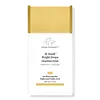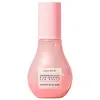What's inside
What's inside
 Key Ingredients
Key Ingredients

 Benefits
Benefits

 Concerns
Concerns

 Ingredients Side-by-side
Ingredients Side-by-side

Water
Skin ConditioningGlycerin
HumectantButylene Glycol
HumectantNiacinamide
SmoothingPropanediol
SolventNeopentyl Glycol Diheptanoate
EmollientMica
Cosmetic ColorantEthylhexyl Olivate
Skin ConditioningC9-12 Alkane
SolventCoco-Caprylate/Caprate
EmollientSclerocarya Birrea Seed Oil
HumectantCetearyl Alcohol
EmollientSimmondsia Chinensis Seed Oil
EmollientDiglucosyl Gallic Acid
Squalane
EmollientSorbitan Sesquiisostearate
EmulsifyingPlukenetia Volubilis Seed Oil
EmollientMorus Alba Leaf Extract
Skin ConditioningCalcium Chloride
AstringentSea Salt
AbrasiveSodium Stearate
CleansingHydroxyethyl Acrylate/Sodium Acryloyldimethyl Taurate Copolymer
Emulsion StabilisingTocopheryl Acetate
AntioxidantQuercetin
AntioxidantPPG-8-Ceteth-20
EmulsifyingSodium Carrageenan
Emulsion StabilisingGlyceryl Acrylate/Acrylic Acid Copolymer
HumectantXanthan Gum
EmulsifyingPhenoxyethanol
PreservativeSodium Metabisulfite
AntioxidantUbiquinone
AntioxidantAcrylates/Beheneth-25 Methacrylate Copolymer
C12-15 Alkyl Benzoate
AntimicrobialCitric Acid
BufferingTetrasodium Glutamate Diacetate
Sodium Citrate
BufferingCeteareth-20
CleansingDipropylene Glycol
HumectantTocopherol
AntioxidantSorbitan Isostearate
EmulsifyingPolysorbate 60
EmulsifyingSodium Hydroxide
BufferingSorbeth-30 Tetraisostearate
EmulsifyingCI 77491
Cosmetic ColorantCI 77492
Cosmetic ColorantCI 77891
Cosmetic ColorantWater, Glycerin, Butylene Glycol, Niacinamide, Propanediol, Neopentyl Glycol Diheptanoate, Mica, Ethylhexyl Olivate, C9-12 Alkane, Coco-Caprylate/Caprate, Sclerocarya Birrea Seed Oil, Cetearyl Alcohol, Simmondsia Chinensis Seed Oil, Diglucosyl Gallic Acid, Squalane, Sorbitan Sesquiisostearate, Plukenetia Volubilis Seed Oil, Morus Alba Leaf Extract, Calcium Chloride, Sea Salt, Sodium Stearate, Hydroxyethyl Acrylate/Sodium Acryloyldimethyl Taurate Copolymer, Tocopheryl Acetate, Quercetin, PPG-8-Ceteth-20, Sodium Carrageenan, Glyceryl Acrylate/Acrylic Acid Copolymer, Xanthan Gum, Phenoxyethanol, Sodium Metabisulfite, Ubiquinone, Acrylates/Beheneth-25 Methacrylate Copolymer, C12-15 Alkyl Benzoate, Citric Acid, Tetrasodium Glutamate Diacetate, Sodium Citrate, Ceteareth-20, Dipropylene Glycol, Tocopherol, Sorbitan Isostearate, Polysorbate 60, Sodium Hydroxide, Sorbeth-30 Tetraisostearate, CI 77491, CI 77492, CI 77891
Water
Skin ConditioningPropanediol
SolventGlycereth-26
HumectantGlycerin
HumectantNiacinamide
Smoothing2,3-Butanediol
Humectant1,2-Hexanediol
Skin ConditioningCetyl Ethylhexanoate
EmollientCitrullus Lanatus Fruit Extract
Skin ConditioningSodium Hyaluronate
HumectantEclipta Prostrata Extract
Skin ConditioningMelia Azadirachta Leaf Extract
Skin ConditioningPolyglyceryl-3 Methylglucose Distearate
EmulsifyingTromethamine
BufferingGlyceryl Stearate
EmollientCarbomer
Emulsion StabilisingAcrylates/C10-30 Alkyl Acrylate Crosspolymer
Emulsion StabilisingEthylhexylglycerin
Skin ConditioningXanthan Gum
EmulsifyingPolyquaternium-51
Skin ConditioningMoringa Oleifera Seed Oil
EmollientParfum
MaskingBenzyl Benzoate
AntimicrobialWater, Propanediol, Glycereth-26, Glycerin, Niacinamide, 2,3-Butanediol, 1,2-Hexanediol, Cetyl Ethylhexanoate, Citrullus Lanatus Fruit Extract, Sodium Hyaluronate, Eclipta Prostrata Extract, Melia Azadirachta Leaf Extract, Polyglyceryl-3 Methylglucose Distearate, Tromethamine, Glyceryl Stearate, Carbomer, Acrylates/C10-30 Alkyl Acrylate Crosspolymer, Ethylhexylglycerin, Xanthan Gum, Polyquaternium-51, Moringa Oleifera Seed Oil, Parfum, Benzyl Benzoate
 Reviews
Reviews

Ingredients Explained
These ingredients are found in both products.
Ingredients higher up in an ingredient list are typically present in a larger amount.
Glycerin is already naturally found in your skin. It helps moisturize and protect your skin.
A study from 2016 found glycerin to be more effective as a humectant than AHAs and hyaluronic acid.
As a humectant, it helps the skin stay hydrated by pulling moisture to your skin. The low molecular weight of glycerin allows it to pull moisture into the deeper layers of your skin.
Hydrated skin improves your skin barrier; Your skin barrier helps protect against irritants and bacteria.
Glycerin has also been found to have antimicrobial and antiviral properties. Due to these properties, glycerin is often used in wound and burn treatments.
In cosmetics, glycerin is usually derived from plants such as soybean or palm. However, it can also be sourced from animals, such as tallow or animal fat.
This ingredient is organic, colorless, odorless, and non-toxic.
Glycerin is the name for this ingredient in American English. British English uses Glycerol/Glycerine.
Learn more about GlycerinNiacinamide is a multitasking form of vitamin B3 that strengthens the skin barrier, reduces pores and dark spots, regulates oil, and improves signs of aging.
And the best part? It's gentle and well-tolerated by most skin types, including sensitive and reactive skin.
You might have heard of "niacin flush", or the reddening of skin that causes itchiness. Niacinamide has not been found to cause this.
In very rare cases, some individuals may not be able to tolerate niacinamide at all or experience an allergic reaction to it.
If you are experiencing flaking, irritation, and dryness with this ingredient, be sure to double check all your products as this ingredient can be found in all categories of skincare.
When incorporating niacinamide into your routine, look out for concentration amounts. Typically, 5% niacinamide provides benefits such as fading dark spots. However, if you have sensitive skin, it is better to begin with a smaller concentration.
When you apply niacinamide to your skin, your body converts it into nicotinamide adenine dinucleotide (NAD). NAD is an essential coenzyme that is already found in your cells as "fuel" and powers countless biological processes.
In your skin, NAD helps repair cell damage, produce new healthy cells, support collagen production, strengthen the skin barrier, and fight environmental stressors (like UV and pollution).
Our natural NAD levels start to decline with age, leading to slower skin repair, visible aging, and a weaker skin barrier. By providing your skin niacinamide, you're recharging your skin's NAD levels. This leads to stronger, healthier, and younger looking skin.
Another name for vitamin B3 is nicotinamide. This vitamin is water-soluble and our bodies don't store it. We obtain Vitamin B3 from either food or skincare. Meat, fish, wheat, yeast, and leafy greens contain vitamin B3.
The type of niacinamide used in skincare is synthetically created.
Learn more about NiacinamidePropanediol is an all-star ingredient. It softens, hydrates, and smooths the skin.
It’s often used to:
Propanediol is not likely to cause sensitivity and considered safe to use. It is derived from corn or petroleum with a clear color and no scent.
Learn more about PropanediolWater. It's the most common cosmetic ingredient of all. You'll usually see it at the top of ingredient lists, meaning that it makes up the largest part of the product.
So why is it so popular? Water most often acts as a solvent - this means that it helps dissolve other ingredients into the formulation.
You'll also recognize water as that liquid we all need to stay alive. If you see this, drink a glass of water. Stay hydrated!
Learn more about WaterXanthan gum is used as a stabilizer and thickener within cosmetic products. It helps give products a sticky, thick feeling - preventing them from being too runny.
On the technical side of things, xanthan gum is a polysaccharide - a combination consisting of multiple sugar molecules bonded together.
Xanthan gum is a pretty common and great ingredient. It is a natural, non-toxic, non-irritating ingredient that is also commonly used in food products.
Learn more about Xanthan Gum